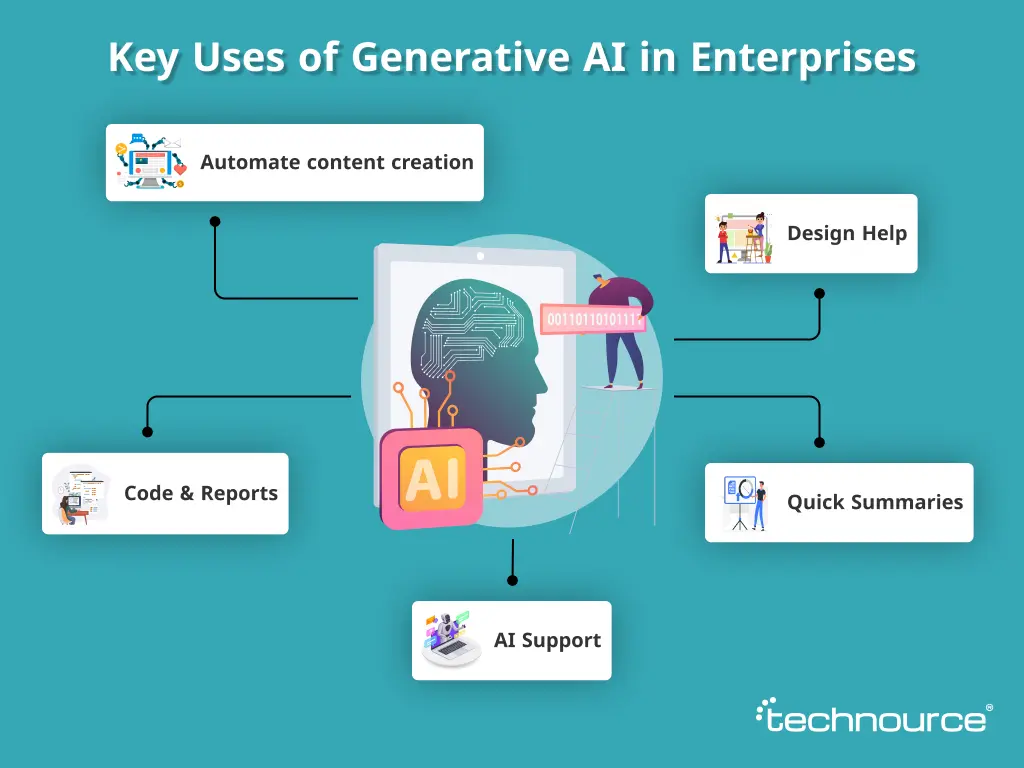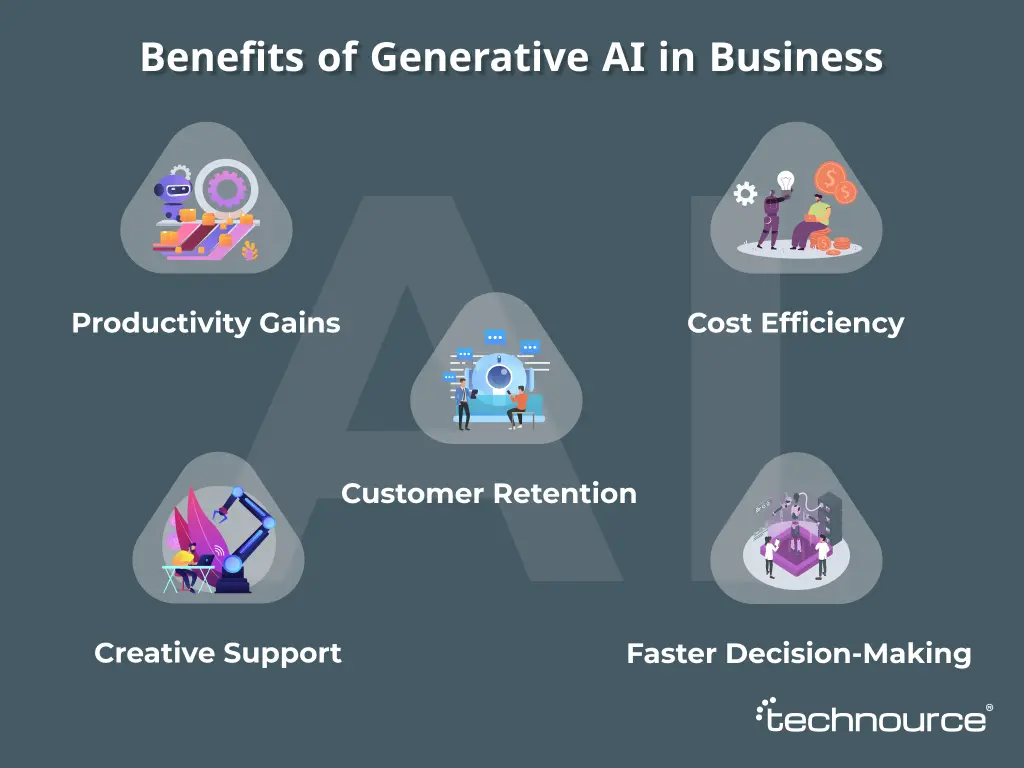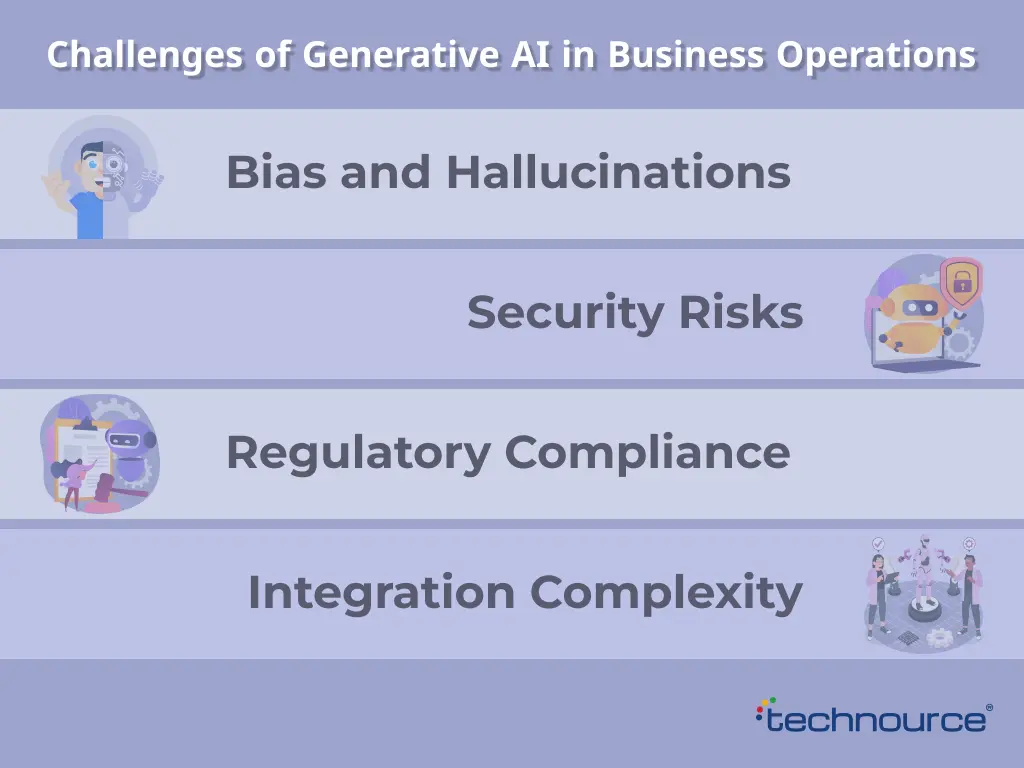The Future of Generative AI in Business: How It Will Change Everything
Quick Summary – Generative AI is no longer a buzzword. it’s becoming a strategic pillar of business transformation. From the automation of content creation to customer experience enhancement and optimization of internal operations, business generative AI is revolutionizing the manner in which organizations create value. The blog explores the details of how generative AI diverges from traditional AI, where it is already making an impact, and how companies can leverage it wisely to drive innovation and competitiveness.
Having gone through waves of cloud, mobile, and DevOps adoption, I can confidently report that generative AI is the first that I’ve observed where developers and non-tech teams are equally excited and equally flummoxed. It doesn’t just automate like other innovations, it co-creates. And that fundamentally shifts everything.
From creating GPT-based customer support assistants to collaborating with marketing teams that are struggling to scale creative output, I’ve witnessed firsthand how incredibly powerful and difficult this technology can be within actual businesses. As we move further into 2025, generative AI in business isn’t an upcoming trend. It’s an existing challenge and an even larger opportunity.
This blog is intended to de-mystify what is real, what is hype, and how companies can use generative AI strategically with tangible ROI and low risk.
What is Generative AI? And How It Differs from Traditional AI
Traditional AI models tend to be created to identify patterns and make decisions, like fraud detection software or recommendation systems. Those are discriminative models. Generative AI is created to produce something new. Whether text, images, music, video, or software code, generative AI uses advanced neural networks to create absolutely new outputs from training data.
Essentially, generative AI operates in models like Large Language Models (LLMs) (e.g., GPT-4, Claude, Gemini) and image generation diffusion models (e.g., DALL·E and Stable Diffusion).
Unlike rule-based systems, these models learn statistical patterns and generate contextually relevant outputs based on prompts.
For instance, OpenAI’s GPT-4 can write legal summaries, technical documentation, and even debug code. Adobe Firefly enables marketers to generate high-quality images with just a few words. These aren’t just enhancements, they are accelerating content production and decision-making in ways previously unimagined. Even in the development sector, AI in mobile app development or innovative software development brings the pace that includes features and functionalities.
Learn more about building tailored AI models in our AI development guide.
Key Uses of Generative AI in Enterprises

Generative AI is the best friend of modern-day companies. Following are the exclusive reasons:
- Automate content creation: Write emails, social media updates, product descriptions etc.
- Code & Reports: Write computer programming or technical reports
- AI Support: Opt for advanced customer support by AI chatbots
- Quick Summaries: Summarize lengthy reports or documents instantly
- Design Help: Assist in product design and prototyping
For example, Jasper is utilized by marketing teams, GitHub Copilot by engineering teams, and Notion AI by internal documentation teams. Integration with top platforms like CRMs or ERPs is gaining popularity, particularly with OpenAI, Google, or AWS APIs.
With the increase in these emerging technologies, generative AI in commercial operations is becoming a necessity rather than a luxury.
Popular Generative AI Tools for Businesses: A Quick Comparison
| Tool | Best For | Type | Strengths | Pricing (As of 2025) |
|---|---|---|---|---|
| ChatGPT (OpenAI) | General text generation, chatbots | Large Language Model (LLM) | Versatile, strong API, GPT-4 Turbo available | Free & paid plans ($20+/mo) |
| Jasper AI | Marketing & sales content | AI Copywriter | Templates for ads, blogs, social posts | Starts at $49/mo |
| Copy.ai | Short-form content & emails | AI Writing Assistant | Simple UX, good for teams | Free & paid ($36+/mo) |
| GitHub Copilot | Code generation for developers | AI Pair Programmer | Autocompletes code, explains snippets | $10/mo (individuals) |
| Midjourney | Image generation | Diffusion model | Artistic visuals, creative control | Discord-based, $10+/mo |
| DALL·E (OpenAI) | Image generation from text | Diffusion model | High-quality images, easy prompt control | Pay-per-image or API |
| Notion AI | Notes, summaries, productivity | Productivity AI | Great for internal documentation & planning | Add-on to Notion plans |
| Claude (Anthropic) | Long context conversations | LLM | Safer design, massive context window | API-based pricing |
| Bard (Google) | Quick research & brainstorming | LLM (PaLM) | Strong search integration, user-friendly | Free (for now) |
How can Generative AI enhance customer experiences?
Generative AI enables tailored, real-time, and elastic customer service. Companies now develop AI chatbots to manage sophisticated interactions with contextual memory to minimize waiting times and enhance satisfaction. E-commerce AI technologies produce dynamic product descriptions, email responses, and even real-time personalized offers based on distinct buyers. In tourism and travel, AI is being used by companies like Expedia to develop itineraries based on user inputs. In banking, virtual agents explain loan options and manage KYC documentation.
Benefits of Generative AI in Business
The benefits of generative AI extend across departments and industries:
- Productivity Gains: Automates repetitive creative work like writing, design, and data entry.
- Cost Efficiency: Reduces headcount for basic content tasks and minimizes human error.
- Creative Support: Assists designers, writers, and strategists with fast idea generation.
- Faster Decision-Making: Summarizes complex data for quick business insights.
- Customer Retention: Enables personalized content, improving satisfaction and loyalty.
According to Gartner report, enterprises using generative AI in marketing and operations reported a 23% increase in productivity and 30% faster time-to-market.
Challenges of Generative AI in Business Operations
Despite the promise, there are serious considerations when deploying generative AI:
- Bias and Hallucinations: AI can produce false or biased outputs, especially in sensitive domains
- Security Risks: Sensitive customer data may be exposed if used carelessly in prompts or training
- Regulatory Compliance: Industries like finance and healthcare must ensure AI output aligns with legal standards
- Integration Complexity: Connecting generative AI with legacy systems requires advanced engineering
Organizations must adopt human-in-the-loop systems and ensure ethical usage of AI content.
Which Industries Are Adopting Generative AI?
Several industries are already seeing tangible ROI from generative AI:
- Retail: AI-generated product listings, reviews, and chatbot support
- Finance: Report automation, fraud detection prompts, customer communications
- Healthcare: Drafting medical documentation, creating synthetic training data
- Education: Personalized lesson plans, grading assistance, interactive tutoring
- Real Estate: AI-driven lead generation, listing automation — read more in our real estate AI blog
How to Implement Generative AI in Your Business
Start small. First, select one use case— something like internal documentation or customer support, that will be valuable and safe to test.
Then:
- Pick a reliable AI tool (e.g., ChatGPT, Gemini, Jasper, Claude)
- Always use synthetic or anonymized data for testing
- Involve both technical and business teams in evaluating outputs
- Document performance and feedback
- Scale thoughtfully with training and monitoring in place
The Future of Generative AI in Digital Transformation
Looking ahead, generative AI will be deeply embedded in enterprise infrastructure. It will:
- Power AI copilots across tools like Microsoft 365, Salesforce, or Slack
- Assist managers in making decisions with dynamic briefings
- Create personalized internal knowledge assistants trained on company data
- Be part of data pipelines, not just a UI tool
According to a C3.ai study, generative AI will drive over $1.3 trillion in enterprise value by 2030.
Companies that start with governed, strategic AI adoption now will shape the digital business landscape over the next decade.
Summing up
From helping a healthcare client reduce manual documentation using custom GPT models, to seeing a fintech startup deploy AI-generated onboarding journeys, I’ve watched generative AI shift from “interesting experiment” to essential business layer.
The future of generative AI in business won’t be about replacing people, it will be about empowering teams, speeding up processes, and surfacing insights that humans alone would miss. But like any transformative tech, it needs guardrails, planning, and a strong implementation partner.
If you are willing to unleash the potential, Technource stands ready to assist you with AI development services. From advisory to deployment, we assist small, medium, and large enterprises in deploying smart, secure, and scalable generative AI solutions.
FAQs
Generative AI is used for content creation, marketing automation, real-time customer service, product development, and code or document creation. Canva, Shopify, and Salesforce are already using it in their everyday business. They can automate customer service, auto-generate reports, personalize messaging, assist with hiring, and automate content generation for social, sales, or web channels. These models are being incorporated into everyday workplace applications for maximum impact. Advantages are quicker content production, enhanced personalization and scalable customer support. Disadvantages are possible inaccuracies, ethical issues, and the need for secure data handling. Companies need to implement it responsibly with compliance and management. Some of the top tools include ChatGPT, Jasper, Bard, Midjourney, and Copy.ai. They are all for different purposes ranging from coding and image creation to writing and customer support. It provides faster, better support via chatbots and email dynamic capabilities. It also enables scale personalization, assisting companies in keeping customers, lowering churn, and enhancing response quality.
Request Free Consultation
Amplify your business and take advantage of our expertise & experience to shape the future of your business.










